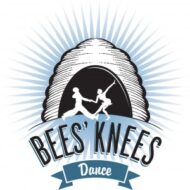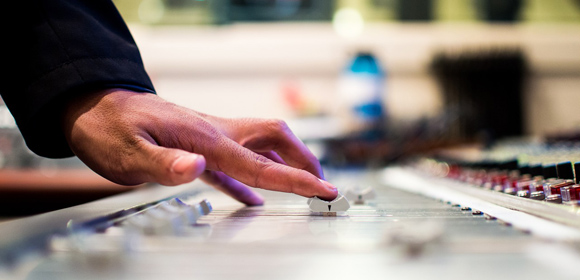When I started DJing for swing dancers I was pretty nervous. Like most beginner DJs I worried that I’d play a song and the dancefloor would clear. At a swing dance, all attention is on the music and if it isn’t right, it’s your fault as a DJ. It feels like a strangely vulnerable position to put yourself in when you start out. So why on earth would anyone want to do that? Especially when you could be dancing instead of sitting behind a computer?
DJing sometimes feels like dancing vicariously. When dancing with a partner, you have a direct influence on the experiences and emotions of that other person. Any swing dancer will understand how rewarding the experience of social dancing is in spite of any fear of being judged at the beginning. I think the same applies to DJing, except that you have a direct influence on a crowd of dancers at any given time. You can probably imagine how rewarding it is to see how your choices of music affect the group as a whole — or even just that one friend you’re watching, who then comes up to you gasping for air saying, “You’re playing all my favorite songs! You’re killing me! I can’t stop dancing.”
But where do you start? Well, there are some obvious things I could tell you, like: get a lot of music… swing music, and find a place to play. But there are some less obvious things I’d like to share with you that will kickstart your DJing.
First: Observe and learn. Sure, DJing is about playing music, but I think it’s equally about paying attention and understanding who you’re playing for. This brings me to my Golden Rule of DJing: Play for everybody but yourself.
I’m NOT saying you should play music you don’t personally enjoy. I’m saying that your job as a DJ is to find out and play what the crowd wants (even if they themselves don’t know what they want). Be cautious about using your own tastes as a reference. You’re not the one dancing, you’ve been sitting at your computer. You also may not be the “average” dancer in the crowd you’re playing for…
Let’s read that Golden Rule again: “Play for everybody…” When I’m DJing, I only spend half my time looking at the people dancing. They’re happy for the most part. I spend the rest of the time looking at who isn’t dancing asking myself, “Why aren’t they dancing?”, “What song could get him to dance?”, “Is she enjoying that conversation, or resorting to it because she’s a beginner and the music is too fast?”, “Are they not dancing because they’re bored?”, “Are they not dancing because they’re tired?”
With the Golden Rule out of the way, let’s get into specifics. I’ve seen many beginner DJs start from a place of loving jazz music, and probably having a collection of songs they like. But you need to really get a good understanding of two things to be a good DJ. Understand swing music, and understand swing dance culture. If you just graduated from a music degree, played in your school swing band, bought the entire Ken Burns Jazz collection, and you’ve got your “rock-step triple step” down, that doesn’t make you a good DJ. Knowledge of jazz music theory, and having a large collection of mp3s, isn’t sufficient (to be honest, it’s probably not really necessary to start either). Spend time thinking about:
- what makes a good birthday jam song?
- what song could you play that would almost for sure fill an empty dance floor?
- are you prepared if someone wants to do a Shim Sham? Tranky Doo? Big Apple?
- if the dance is filled with beginner dancers that just learned lindy hop, what do you play for the first hour? What if those beginners just learned charleston? Balboa?
These aren’t rhetorical questions. They have answers, although the answers may differ from DJ to DJ. As you gain more experience you may develop your own answers to these questions, but in the mean time, here are mine.
What makes a good birthday jam song?
The speed of the song will depend on who’s birthday it is… but in general you want something uplifting that sounds good to clap to… because people will be clapping. You probably don’t want to go too fast, even if all of the advanced dancers were born this month. The song shouldn’t have any abrupt tempo changes either. Here are some examples:
What song could you play that would almost for sure fill an empty dance floor?
Again, it depends who’s dancing. If I’m DJing for the local university swing club (UT-Swing), I might put on something like Jump, Jive an’ Wail. If the crowd is mixed I’ll play something like Splanky… everybody loves that song, or C Jam Blues. If there are a good number of experienced dancers I’ll play T’aint What You Do and start a shim sham… and follow it up with something equally upbeat. Notice that none of these songs are very fast… because a crowd of sitting dancers will never jump up to dance to Jumping at the Woodside.
Are you prepared if someone wants to do a Shim Sham? Tranky Doo? Big Apple?
Well… I am. These are all mob dances. The songs used for them may very between swing scenes so make sure you have ones that will work within your swing scene. Here are some that I use in Toronto.
If the dance is filled with beginner dancers that just learned lindy hop, what do you play for the first hour? What if those beginners just learned charleston? Balboa?
If I’m playing the first set right after a beginner lesson, first of all, I’m going to try to be at least five minutes early so I can catch the end of the beginner lesson and hear what the teachers were using for their lesson. The tempo of the last song they play is what I’ll try to match. Here’s where it gets tricky. Sure, there are really slow swing songs… but if you’re trying to get a bunch of (potentially) timid beginners dancing, it’s got to be a good song too. Once I establish the comfort level I’ll slowly try to boost the speed. If the beginners are excited about this new skill, this will be easy. Sometimes, i just need to stay at a low tempo.
The same thing applies to charleston and balboa, but the songs will be different to accommodate these different styles. (eg: I wouldn’t play splanky for a class that just learned charleston). Here are sets of three songs that I might play after a beginner lesson for Lindy, Charleston, and Balboa.
Hopefully that’ll give you some things to think about, and directions to look for building your library… So, let’s talk about the jitters. If you’re nervous about starting to DJ, there are some things you should keep in mind. You don’t have to dive into the deep end right away. You can DJ at low-key events, and maybe even just a small set of 15 minutes. Ask an established DJ if you could take over 15 minutes of one of their sets as a starter. Maybe go earlier in the evening so you don’t need to worry about all your songs being played before you have a chance. That also gives you the added benefit of someone to take over if anything goes awry.
If you’re worried about the dance floor clearing… well… it happens. Sometimes it’s the song, but sometimes everyone just decides to take a break at the same time. Don’t be discouraged when it happens, because the opposite is equally possible. Some other night, everyone may decide to dance their faces off to your music. And for that one night, you’ll be a hero…
…or something. Just have fun and don’t worry.


